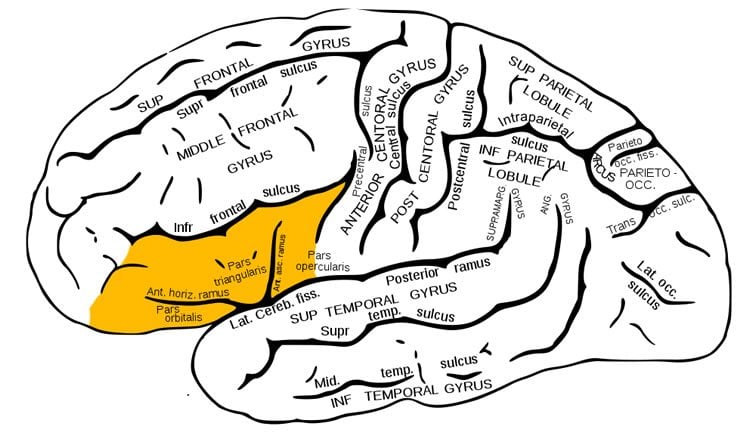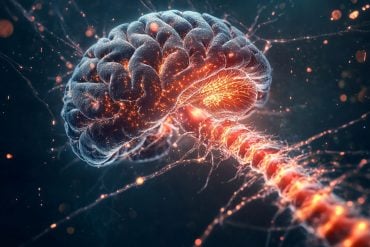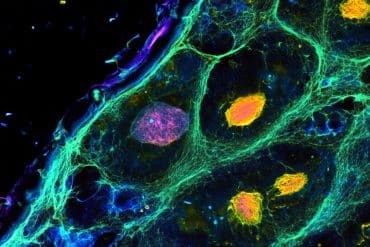Summary: According to researchers, healthy people with a smaller inferior frontal cortex are more prone to anxiety and tend to view neutral events negatively.
Source: University of Illinois at Urbana Champaign.
Healthy college students who have a relatively small inferior frontal cortex – a brain region behind the temples that helps regulate thoughts and emotions – are more likely than others to suffer from anxiety, a new study finds. They also tend to view neutral or even positive events in a negative light, researchers report.
The researchers evaluated 62 students, collecting brain structural data from neuroimaging scans and using standard questionnaires to determine their level of anxiety and predilection for negative bias.
Previous studies of people diagnosed with anxiety have found similar correlations between the size of the IFC and anxiety and negative bias, said U. of I. psychology postdoctoral researcher Sanda Dolcos, who led the study with graduate student Yifan Hu. But the new findings, reported in the journal Social Cognitive and Affective Neuroscience, are the first to see these same dynamics in healthy adults, the researchers said.
“You would expect these brain changes more in clinical populations where anxiety is very serious, but we are seeing differences even in the brains of healthy young adults,” Dolcos said.
The study also found that the relationship between the size of the IFC and a student’s negative bias was mediated by their level of anxiety.
“People who have smaller volumes have higher levels of anxiety; people who have larger IFCs tend to have lower levels of anxiety,” Dolcos said. And higher anxiety is associated with more negative bias, she said. “How we see this is that the higher volume of the IFC confers resilience.”
“We found that larger IFC volume is protecting against negative bias through lower levels of trait anxiety,” Hu said.
According to the American College Health Association, anxiety is rampant on college campuses, where nearly 60 percent of students report at least one troubling bout of anxious worry every year.

“There is a very high level of anxiety in the student population, and this is affecting their life, their academic performance, everything,” Dolcos said. “We are interested in identifying what is going on and preventing them from moving to the next level and developing clinical anxiety.”
Anxiety can interfere with many dimensions of life, causing a person to be on high alert for potential problems even under the best of circumstances, Hu said. Negative bias also can interfere with a person’s commitment to activities that might further their life goals, she said.
Understanding the interrelatedness of brain structure, function and personality traits such as anxiety and their behavioral effects such as negative bias will help scientists develop interventions to target specific brain regions in healthy populations, Hu said.
“We hope to be able to train the brain to function better,” she said. “That way, we might prevent these at-risk people from moving on to more severe anxiety.”
Funding: The Brain and Behavior Research Foundation and Health Minds Canada supported this research.
Source: Diana Yates – University of Illinois at Urbana Champaign
Image Source: NeuroscienceNews.com image is in the public domain.
Original Research: Full open access research for “Trait anxiety mediates the link between inferior frontal cortex volume and negative affective bias in healthy adults” by Yifan Hu and Sanda Dolcos in Social Cognitive and Affective Neuroscience. Published online March 1 2017 doi:10.1093/scan/nsx008
[cbtabs][cbtab title=”MLA”]University of Illinois at Urbana Champaign “Study Links Brain Structure, Anxiety and Negative Bias in Healthy Adults.” NeuroscienceNews. NeuroscienceNews, 13 April 2017.
<https://neurosciencenews.com/anxiety-brain-structure-6405/>.[/cbtab][cbtab title=”APA”]University of Illinois at Urbana Champaign (2017, April 13). Study Links Brain Structure, Anxiety and Negative Bias in Healthy Adults. NeuroscienceNew. Retrieved April 13, 2017 from https://neurosciencenews.com/anxiety-brain-structure-6405/[/cbtab][cbtab title=”Chicago”]University of Illinois at Urbana Champaign “Study Links Brain Structure, Anxiety and Negative Bias in Healthy Adults.” https://neurosciencenews.com/anxiety-brain-structure-6405/ (accessed April 13, 2017).[/cbtab][/cbtabs]
Abstract
Trait anxiety mediates the link between inferior frontal cortex volume and negative affective bias in healthy adults
Anxious individuals tend to show a negative affective bias in attention that likely reflects reduced executive control, a cognitive function associated with the inferior frontal cortex (IFC), particularly its posterior segment, pars opercularis. Here, we investigated the relations among gray matter volume in the pars opercularis of IFC, trait anxiety, and negative biases in attention, in healthy participants. Sixty-two adults underwent structural magnetic resonance imaging scanning, completed a trait anxiety measure, and performed an Affective Go/No-Go (AGN) task. IFC volumes were extracted using Freesurfer, and negative bias scores were calculated from AGN performance. Trait anxiety correlated negatively with left IFC volume, and positively with the negative bias in reaction time. Furthermore, trait anxiety mediated the negative relation between the IFC volume and the negative bias measure. Overall, the present findings extend previous understanding of the IFC involvement in anxiety at the structural level, and may inform the development of intervention programs targeting anxiety.
“Trait anxiety mediates the link between inferior frontal cortex volume and negative affective bias in healthy adults” by Yifan Hu and Sanda Dolcos in Social Cognitive and Affective Neuroscience. Published online March 1 2017 doi:10.1093/scan/nsx008






